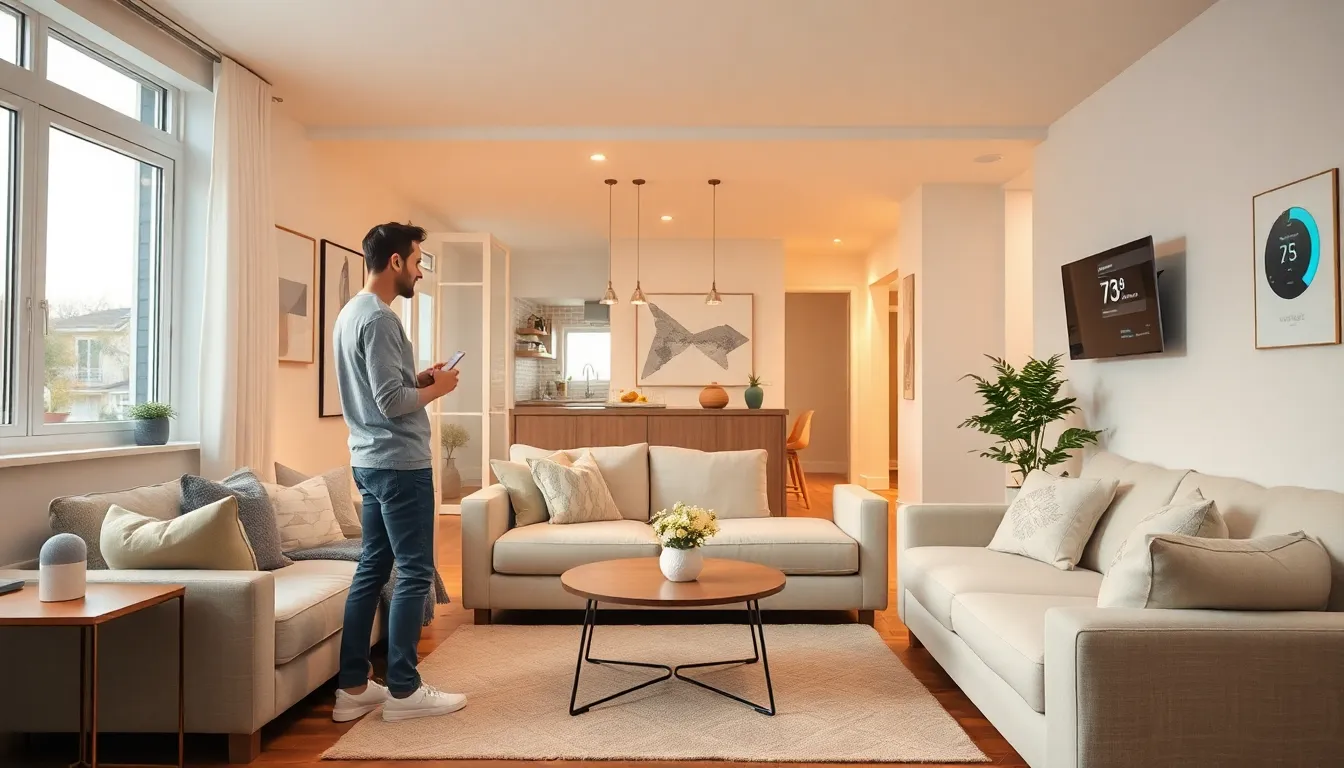Imagine walking into your home and having it greet you like an old friend. With home automation, that dream can become a reality. From smart lighting that adjusts to your mood to thermostats that know when you’re cold (or just pretending to be), home automation transforms mundane living into a seamless experience.
Table of Contents
TogglePopular Home Automation Ideas
Home automation transforms spaces into smart environments. Integrating technology enhances comfort, efficiency, and security throughout the home.
Smart Lighting Solutions
Smart lighting systems provide customized experiences. Homeowners control brightness and color through mobile apps or voice commands. These systems can sync with daily routines, adjusting based on time of day. Energy-efficient LED bulbs reduce energy consumption significantly. Persona-based settings create ambiance for activities like reading or entertaining. Motion sensors automatically turn lights on and off, promoting convenience and security.
Automated Climate Control
Automated climate control systems enhance overall comfort. Smart thermostats learn individual temperature preferences and adapt accordingly. Users can adjust settings remotely using mobile devices. These systems often integrate weather forecasts to optimize energy use. Sensors monitor humidity and air quality, ensuring a healthy indoor environment. Programmable schedules allow for energy savings during unoccupied periods or overnight.
Security and Surveillance Systems
Security and surveillance systems bolster home protection. Smart cameras provide live feeds accessible from smartphones at any time. Motion detection alerts homeowners of potential intruders instantly. Automated door locks enhance security, allowing remote access management. Integrated alarms connect with emergency services, ensuring quick responses. Doorbell cameras add an extra layer of monitoring, enabling two-way communication with visitors.
Innovative Home Automation Technologies

Innovative home automation technologies streamline daily tasks and enhance comfort. These solutions create a more responsive living environment that adapts to individual preferences.
Voice Assistants
Voice assistants elevate home automation by offering hands-free control of various devices. Users can command smart lights and thermostats using simple voice phrases. Popular options like Amazon Alexa and Google Assistant facilitate seamless integration with multiple smart home systems. Compatibility with a wide range of devices allows for a tailored experience. Through voice commands, adjustments can occur in an instant, making home management straightforward and efficient.
Smart Sensors and Alerts
Smart sensors enhance home security and energy efficiency through real-time monitoring. For instance, motion sensors detect movement and trigger alerts, keeping homeowners informed of suspicious activity. Temperature sensors help regulate indoor comfort by signaling HVAC systems to adjust settings based on real-time conditions. Additionally, water leak sensors provide notifications about potential flooding. Implementing these sensors fosters a safer, more energy-conscious environment.
Practical Benefits of Home Automation
Home automation leads to numerous practical benefits that enhance daily life in various ways.
Energy Efficiency
Energy efficiency improves significantly through automated technologies. Smart thermostats adjust temperatures based on user habits, reducing unnecessary heating and cooling. Energy monitoring systems provide data on usage patterns, enabling homeowners to identify energy-wasting devices. Additionally, smart lighting systems automatically turn off when no one is present, further minimizing electricity costs. These system integrations result in lower utility bills and a smaller carbon footprint.
Enhanced Security
Enhanced security represents a crucial advantage of home automation. Smart surveillance cameras provide real-time monitoring of property, allowing users access through mobile applications. Motion detectors send instant alerts when unusual activity occurs, ensuring prompt responses to potential threats. Automated door locks enable remote locking and unlocking, adding convenience and peace of mind. These interconnected security devices create a comprehensive protection plan, fostering safety for families and their homes.
Convenience and Comfort
Convenience and comfort are key benefits of adopting home automation systems. Voice-activated assistants allow users to control various devices hands-free, improving multitasking capabilities in daily routines. Automated blinds adjust based on sunlight, enhancing both comfort and energy savings. In addition, smart home systems learn individual preferences, customizing settings for lighting and temperature at different times of day. Such integration creates an environment that adapts seamlessly to homeowners’ needs, making life more enjoyable.
Tips for Implementing Home Automation
Implementation of home automation involves careful planning. Following these tips can streamline the process for a more personalized living space.
Setting a Budget
Establishing a clear budget is essential for effective home automation. Homeowners should consider costs associated with devices, installation, and potential subscription services. Allocate a specific amount for initial purchases, starting with essential items like smart lights and thermostats. An overview of anticipated expenses ensures smarter choices, avoiding overspending on unnecessary gadgets. Evaluating long-term savings on energy bills also plays a role, highlighting the financial benefits of investing in automation technologies.
Choosing Compatible Devices
Selecting compatible devices enhances functionality within a smart home system. Research is key before making purchases; not all devices work seamlessly together. Homeowners should opt for products that support common protocols, such as Zigbee or Z-Wave. Ensuring compatibility between devices and existing infrastructure can minimize integration challenges. Reading reviews and checking manufacturer guidelines help in making informed decisions, leading to a more cohesive automation experience.
Planning Your Smart Home Network
A solid plan for the smart home network is crucial for optimal performance. Start with a reliable Wi-Fi router capable of supporting multiple devices. Placement of the router affects connectivity; ensuring it’s centrally located can enhance signal strength. Create a dedicated network for smart devices to boost security and keep them from interfering with personal devices. Using extenders or mesh systems improves coverage additionally, preventing dead spots in the home.
Embracing home automation opens the door to a more convenient and efficient lifestyle. By integrating smart technology into daily routines homeowners can enjoy enhanced comfort and security while reducing energy costs. The possibilities are vast from intuitive lighting to advanced security systems that adapt to individual needs.
As technology continues to evolve the potential for creating a truly smart home will only grow. With careful planning and the right devices homeowners can transform their living spaces into personalized havens that respond seamlessly to their preferences. Investing in home automation not only elevates everyday living but also fosters a more sustainable and secure environment for the future.








